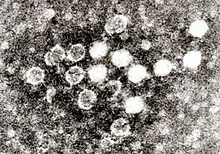
Back Monodnaviria German Monodnaviria Spanish مونودناویریا Persian Monodnaviria French Monodnaviria ID モノドナウィリア Japanese Monodnaviria Dutch Monodnaviria Russian Monodnaviria Ukrainian 單鏈去氧核糖核酸病毒域 Chinese
| Monodnaviria | |
|---|---|

| |
| Parvoviruses in blood | |
| Virus classification | |
| (unranked): | Virus |
| Realm: | Monodnaviria |
| Subtaxa | |
Monodnaviria is a realm of viruses that includes all single-stranded DNA viruses that encode an endonuclease of the HUH superfamily that initiates rolling circle replication of the circular viral genome. Viruses descended from such viruses are also included in the realm, including certain linear single-stranded DNA (ssDNA) viruses and circular double-stranded DNA (dsDNA) viruses. These atypical members typically replicate through means other than rolling circle replication.
Monodnaviria was established in 2019 and contains four kingdoms: Loebvirae, Sangervirae, Trapavirae, and Shotokuvirae. Viruses in the first three kingdoms infect prokaryotes, and viruses in Shotokuvirae infect eukaryotes and include the atypical members of the realm. Viruses in Monodnaviria appear to have come into existence independently multiple times from circular bacterial and archaeal plasmids that encode the HUH endonuclease. Eukaryotic viruses in the realm appear to have come into existence multiple times via genetic recombination events that merged deoxyribonucleic acid (DNA) from the aforementioned plasmids with capsid proteins of certain RNA viruses. Most identified ssDNA viruses belong to Monodnaviria.
The prototypic members of the realm are often called CRESS-DNA viruses. CRESS-DNA viruses are associated with a wide range of diseases, including diseases in economically important crops and a variety of diseases in animals. The atypical members of the realm include papillomaviruses and polyomaviruses, which are known to cause various cancers. Members of Monodnaviria are also known to frequently become integrated into the DNA of their hosts as well as experience a relatively high rate of genetic mutations and recombinations.